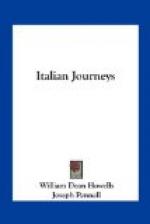but she is practically almost as profoundly at rest
under the King of Italy. One may walk long through
the longitude and rectitude of many of her streets
without the encounter of a single face: the place,
as a whole, is by no means as lively as Pompeii, where
there are always strangers; perhaps the only cities
in the world worthy to compete with Ferrara in point
of agreeable solitude are Mantua and Herculaneum.
It is the newer part of the town—the modern
quarter built before Boston was settled or Ohio was
known—which is loneliest; and whatever
motion and cheerfulness are still felt in Ferrara
linger fondly about the ancient holds of life—about
the street before the castle of the Dukes, and in
the elder and narrower streets branching away from
the piazza of the Duomo, where, on market days, there
is a kind of dreamy tumult. In the Ghetto we were
almost crowded, and people wanted to sell us things,
with an enterprise that contrasted strangely with
shopkeeping apathy elsewhere. Indeed, surprise
at the presence of strangers spending two days in Ferrara
when they could have got away sooner, was the only
emotion which the whole population agreed in expressing
with any degree of energy, but into this they seemed
to throw their whole vitality. The Italians are
everywhere an artless race, so far as concerns the
gratification of their curiosity, from which no consideration
of decency deters them. Here in Ferrara they
turned about and followed us with their eyes, came
to windows to see us, lay in wait for us at street-corners,
and openly and audibly debated whether we were English
or German. We might have thought this interest
a tribute to something peculiar in our dress or manner,
had it not visibly attended other strangers who arrived
with us. It rose almost into a frenzy of craving
to know more of us all, when on the third day the
whole city assembled before our hotel, and witnessed,
with a sort of desperate cry, the departure of the
heavy-laden omnibus which bore us and our luggage from
their midst.
IV.
I doubt if, after St. Mark’s in Venice, the
Duomo at Parma, and the Four Fabrics at Pisa, there
is a church more worthy to be seen for its quaint,
rich architecture, than the Cathedral at Ferrara.
It is of that beloved Gothic of which eye or soul
cannot weary, and we continually wandered back to
it from other more properly interesting objects.
It is horribly restored in-doors, and its Renaissance
splendors soon drove us forth, after we had looked
at the Last Judgment by Bastianino. The style
of this painting is muscular and Michelangelic, and
the artist’s notion of putting his friends in
heaven and his foes in hell is by no means novel; but
he has achieved fame for his picture by the original
thought of making it his revenge for a disappointment
in love. The unhappy lady who refused his love
is represented in the depths, in the attitude of supplicating
the pity and interest of another maiden in Paradise




